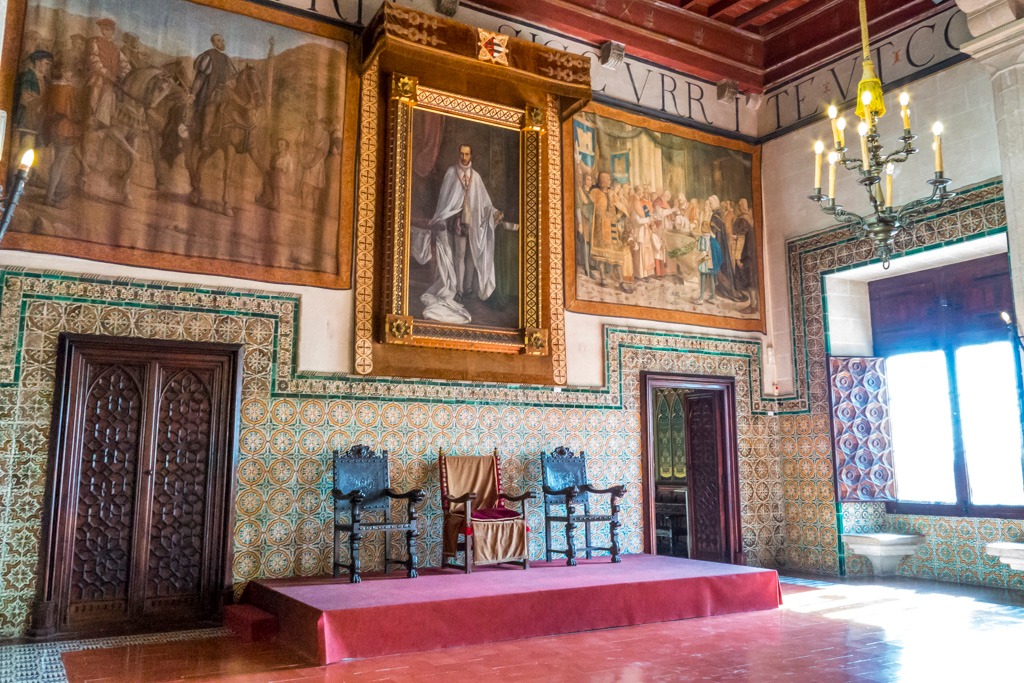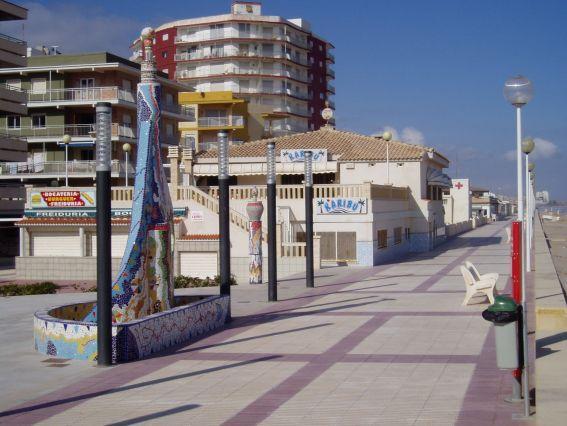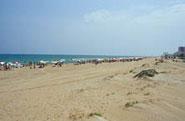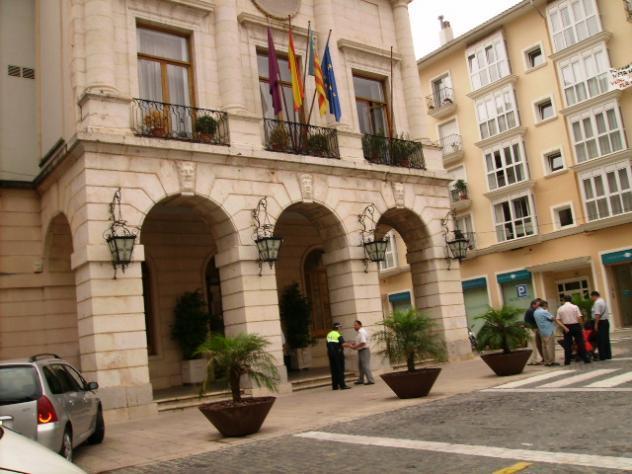Gandía, Comunidade Valenciana, Spain
Suggest Place to Visit
4961
Track to location with GPS |
 |
Until quite advanced times of the Upper Paleolithic, there were no vestiges of human occupation in the territory that today constitutes the municipality of Gandía, but already at this stage, during the final Gravettian, the Cro-Magnon man settled in the Parpalló Cave , a cave that will be inhabited for several thousand years, until almost the end of the Magdalenian.
The Barranco del Llop and Maravillas caves were also inhabited during the Upper Paleolithic.
In contrast to the richness of Palaeolithic, Neolithic and Eneolithic sites, there is the scarcity of remains from the Bronze Age and the little representation of those from Iberian and Roman times.
The occupation of the hill of Castillo de San Juan in Iberian times is proven, surely from the 4th century BC. C., because although the medieval constructions have made all vestige of the town's buildings disappear, Iberian ceramics and fragments of Attic vessels with red figures and black varnish have been collected that can only belong to an establishment of the indicated date and culture . Iberian coins have also been collected in places not located.
Romanization is well represented in this territory. In the city of Gandía, coins and tombstones have been found that could indicate a settlement already in imperial times that perhaps was the remote antecedent of the current population, and vases and other Roman remains in the Penjada, Meravelles and de los Cerdos caves. The latter has produced abundant fragments of ´´terra sigillata´´.
The origin of the current Gandía dates back to the Muslim era, and the first documented Christian mention, in 1249, appears in the ´´Libre del Repartiment´´ by Jaime I of Aragón who donated the town to his son the infant Pedro.
Alfonso IV the Benign imitated his predecessors in favor of the fortification of the town and Pedro IV the Ceremonious ceded for this purpose, in 1387, to the City Council, the right of arm's length. King Martín el Humano later donated it, with the title of duchy, to Alfonso de Aragón, son of the Infante Pedro.
In 1485 the Duchy of Gandía passed to the house of Borja. The medieval city, of feudal character, which after the death of the last duke of royal blood had returned to the Crown, became stately from 1494, in which the second Duke of Borja established a small but lavish court there.
In 1520 the uprising of the Germanías took place, which from Valencia spread to the most important populations of the Kingdom, including Gandía. The uprising triumphed in Valencia and Játiva. The battle of Vernisa, in July 1521, gave the victory to the Germans, who occupied Gandía and its region, and forced the Moors to convert to Christianity. But after the final defeat of the Germans, Juan de Borja returned to Gandía and married Francisca de Castro.
Juan was succeeded by his eldest son Francisco (1543-1551), who was born in 1510, and who renounced his titles and assets in favor of his son Carlos in 1551 to become ordained and enter the Society of Jesus.
On the other hand, Francisco de Borja, who would be canonized in 1671, undertook walling works and incorporated the new enclosure to the Vila-nova, thus protecting it from the danger of pirates, Turks and corsairs in the service of the King of France. Also within the new enclosure, he ordered the construction of a college for which, in 1548, he achieved a papal bull that elevated it to the category of University. This university, located in the place now occupied by the Pious Schools, was famous in its two centuries of life, until its suppression by Carlos III in 1772, after the expulsion of the Jesuits who ran it in 1767, and they passed through it names like Baltasar Gracián, Juan Andrés and Antonio José de Cavanilles.
Gandía maintained its rank throughout the 16th century but, starting in 1609, with the expulsion of the Moors and the ruin of the sugar mills they managed, it suffered catastrophic economic and demographic consequences that took more than 150 years to recover.
During the stagnation period, which lasted until the second half of the 18th century, the dukes left their residence to settle in Madrid. During the War of Succession, the Duke of Gandía took the party of Felipe de Anjou, when all the rest of the Kingdom did it for Archduke Carlos. Hence, General Juan Bautista Basset, from the Austracist party, took the city of Gandía and took the artillery from the then fortified square.
With the triumph of the Bourbons, everything was restored except political life, since the dukes hardly made a brief visit to their palace. In 1740 the last Borja y Centelles died in Madrid, and the duchy passed to his nephew, the Count-Duke of Benavente; Eight years later he would inherit his daughter, married to the Duke of Osuna. With Carlos III, economic life was renewed, and Gandía began a prosperous era of industrialization.
In the 19th century, silk went through two major crises, one due to the epidemic that wiped out almost all the silkworm in the middle of the century, and the other to foreign competition. The railway, symbol of nineteenth-century expansion, arrived with the narrow-gauge Tren Alcoy Gandía and Puerto lines and with the connection between Denia and Carcagente. In the provincial division of 1822 it was assigned to the Province of Játiva and in the division of 1833 to that of Alicante, finally passing to Valencia in 1836.
During the civil war, its population suffered multiple bombings by Mussolini's Italian aviation.
In the 1960s, and due to the great urban growth of the city, the municipality of Gandía annexed the until then independent municipalities of Beniopa and Benipeixcar, currently neighborhoods of the city.
Gandía (in Valencian and officially, Gandia) is a city of the Valencian Community (Spain). It is located in the southeast of the province of Valencia and is the capital of the La Safor region. It has a population of 81,950 inhabitants, making it the seventh most populated city and one of the most important in the autonomous community, also due to its location close to the borders of the provinces of Valencia and Alicante. Gandía is one of the main Spanish tourist destinations, which is why in summer the city triples its population until reaching 350,000 inhabitants in August.
Monuments
Ducal Palace of Gandía
Urban helmet. The medieval nucleus of the town was around the streets of Río, Mayor and Plaza. Other side streets flowed to them. It was surrounded by a wall built in the early 14th century. In the northeast part was the Jewish quarter. The morería (rabal) was separated from the town and had a mosque on the site of the church of San José. At the end of the 16th century, a continuous series of earthquakes caused many buildings to collapse. The walls disappeared at the end of the 19th century, leaving today only three towers between the Colegio de las Escuelas Pías and the river, the Torreón del Pino and the Torreta on Pérez de Culla Street.
Church of Santa Maria. It has been a collegiate church since 1499. The temple was probably built in the late 14th or early 15th century. It is in the Gothic style, mixed with others from different periods. It was expanded in the 16th century. It featured valuable works of art, such as the altarpiece of the main altar, the work of Paolo de San Leocadio, on a carving of Damiá Forment, the choir of the s. XVI and a valuable treasure, highlighting the processional custody, a masterpiece of the s. XVI. All this was destroyed in 1936 during the civil war, as well as its very rich archive. It has two Gothic doors: that of Santa María and that of the Apostles, the latter by Damián Forment, with beautiful figures that disappeared in 1936 and are in the process of being restored.
Ducal Palace of Gandía. Among the most important monuments of the city is the Doge's Palace, which has undergone numerous restorations. Birthplace of San Francisco de Borja. The Gothic Weapons Patio and the Golden Gallery, from the s. XVII, with original tiles of the time. It is considered one of the most important stately mansions of the Crown of Aragon. Francisco de Borja's room is preserved practically as it was at that time and it is not allowed to step on it, it can only be seen from the outside.
Town hall. It occupies a building with a neoclassical façade on which you can read an inscription with the name of the King of the moment, Carlos III.
Local parties
Saint Anthony the Abbot. On January 17, San Antonio Abad (Sant Antoni del Porquet) is venerated, with bonfires included.
Failures From March 16, the typical Fallas are celebrated, burned on the night of the 19th, the day of San José. The city of Gandía has 23 fallas (21 in the city and 2 in the Grao de Gandía).
Holy Week. Festival of National Tourist Interest. The city has 18 brotherhoods of Holy Week. To highlight the Holy Thursday Encounter between the Sorrowful and the Nazarene, the Holy Burial procession on Good Friday and the Glorious Encounter on Easter Sunday between the Virgin of Solitude and the Nazarene. The Visitatio Sepulcri, a musical work attributed to San Francisco de Borja, is also performed.
Saint John Baptist. The night between June 23 and 24, the bonfires of San Juan are burned, traditional throughout the Mediterranean coast, celebrating the beginning of summer.
Virgin of Carmen. On July 16, seafaring festivals in honor of the Virgen del Carmen, in the Grao de Gandía (port area).
Fair and Festivities: Around October 3, in honor of the municipal patron, San Francisco de Borja. The main character of the Fair and Festivities is the Tio de la porra.
Comments
We don´t have yet any comments about:
Gandia
Gandia
Be the first to leave a comment as it is very important to inform other people
Outros locais a visitar
Within a radius of 20 km from:Gandia
Marxuquera (Gandía) |
| 2,7 Km |
 |
Ducal Palace of Gandia |
| 4,1 Km |
 |
Bellreguart |
| 6,8 Km |
 |
Daimus |
| 7,2 Km |
 |
Daimús |
| 7,3 Km |
 |
Playa Bellreguard |
| 8,2 Km |
 |
Font Salada or Ullal del Burro |
| 16,0 Km |
 |
Hotel reservation near Gandia within a radius of 20 km
Why to book with CLUBE TRAVEL
The best prices
Our partnerships with the world´s largest operators offer research on the best market prices.
More options
At Rotas Turisticos you can book the hotel, buy the air ticket, book the transfer from the airport to the hotel and vice versa, book the local excursions, rent the car, take travel insurance and consult the places to visit and where to go.
Holiday Tips & Destinations
Hundreds of holiday destinations with all the options that allow you to easily choose the destination that best suits your dream vacation.
CLUBE TRAVEL
Links






